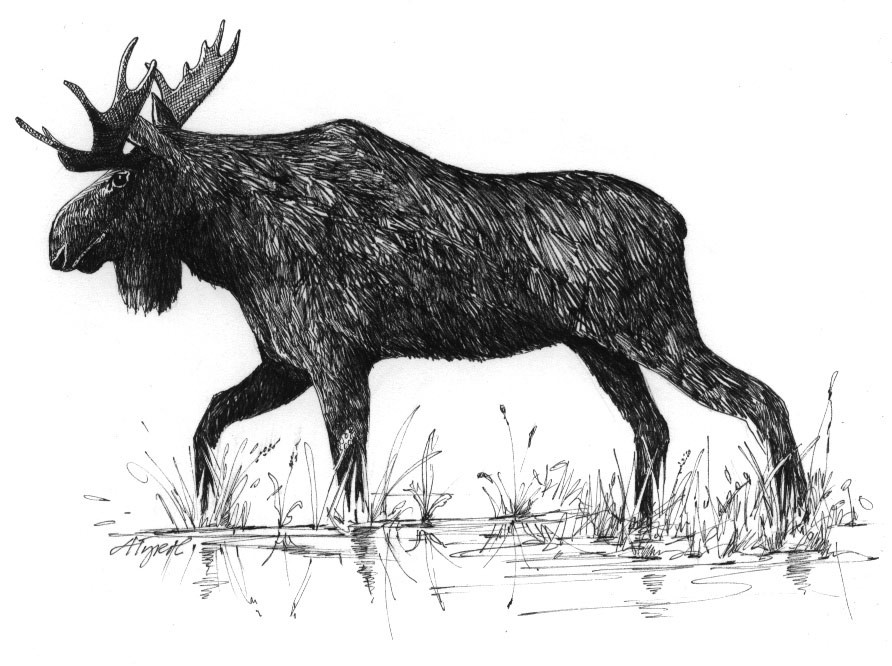
Sorry, Rocky. There is no such thing as a friendly moose.
There are several reasons why a moose might appear to be friendly, or at least not afraid of people, says Kristine Bontaites, moose project leader for the New Hampshire Fish and Game Department.
In spring, yearlings get kicked out by their mothers (which may be why moose moms don’t get Mother’s Day cards) and sometimes wander in a daze. These spurned yearlings may hang around shopping centers or even follow a human around, she says.
And then there are friendly-seeming adult moose that may not feel the need to run. “They don’t have flight response like white-tailed deer,” she says. “They don’t have to run away because they are the biggest thing out there.”
But another explanation for tolerant moose, especially those walking in circles like someone who dropped her car keys in the grass, is brainworm. Brainworm is also known as “moose sickness” even though the moose’s role in the brainworm world is minor.
It is the white-tailed deer that star in this world, but because the deer are unaffected by brainworm, even by several worms crawling around in their brains, it is the afflicted moose that get top billing.
In New Hampshire, about 70 percent of the white-tailed deer are packing some brainworm, says Bontaites. In Vermont, the number is about 85 percent, says Cedric Alexander, the moose team leader for Vermont Fish and Wildlife.
The worm in brainworm is a parasitic nematode (or roundworm), with a scientific name that is about as long as it is. Parelaphostrongylus tenuis is two to three inches long and one-hundredth of an inch in diameter. Bontaites and Alexander, who have seen them in person, say they look like hairs.
But brainworm does not go from deer brain to moose brain like a bad thought. While escargot is not on the menu for either deer or moose, it is snails and slugs that transport nematodes from one hoofed creature to another.
Nematode larvae exit the deer (because it is almost always a deer) by the back door and live on in their droppings. Snails and slugs crawl over the droppings, are infected by the larvae, and slither on. The larvae go through two more stages inside the snail or slug, which then gets eaten, quite accidentally, by another deer or a moose.
It is a crazy, seemingly inefficient system, yet it works – for the brainworm at least. (Don’t forget that B-plus average for infection in Vermont deer.)
The moose, alas, do not take the infection well, and it is often fatal. Humans, however, have nothing to fear. The nematodes don’t seem interested in our brains, so it’s safe to eat the flesh of even infected deer and moose. (Bontaites wisely cautions against eating the brain or spinal cord of an infected animal – not that you need much discouragement.)
The nematodes probably couldn’t make a living on moose alone. The infection rate for moose is roughly three percent in New Hampshire and very roughly five percent in Vermont, according to Bontaites and Alexander. Brainworms evolved with white-tailed deer, and the moose play only an accidental role in their lifecycle.
Brainworm accidents are more likely to happen when moose cross paths with white-tailed deer. In the last five years in the northern third of Vermont, where the moose density is high and the deer density is low, 10 moose are believed to have had brainworm, says Alexander. In the southern third, where the deer are two to three times as dense (in population, not intellect) 20 moose – twice as many – are believed to have had brainworm, he reports.
However, Alexander doesn’t see brainworm as a problem. “A problem for one species is a boon for another,” he says. “A moose that dies out in the woods is going to be a feast for the bears, coyotes and other scavengers.” Dinner is served, compliments of the brainworm.
It’s another story when moose are sick in a populated area. Wardens will kill an infected moose deemed likely to stumble into a highway, for example, or to spare a family from watching a moose waste away and drop dead in the backyard.
Alexander worries that, while we know what to expect from Bullwinkle, we don’t know how real moose behave. When a moose is clumsy, disoriented, or approachable, it is sick, he says. Bontaites notes that a sick moose is still capable of hurting or even killing you. It should not be treated like a cartoon character.
If you do spot a moose talking to a flying squirrel, though, just point him in the direction of Frostbite Falls. Since real moose are not friendly, the place is not the same without him.

